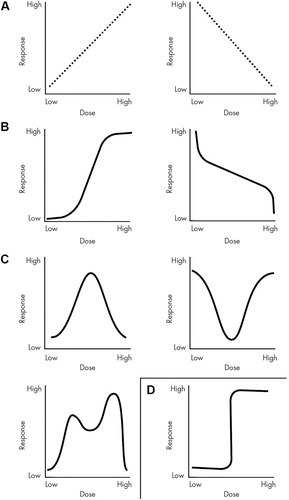
Why we no longer have to take notice of claims that GMO crops and herbicides are not causing us harm
Comment by Claire Robinson of GMWatch:
Derek Bickerton is a retired professor of linguistics who has studied biology and noticed massive holes in the scientific arguments of the pro-GMO brigade. Based in Hawaii, he’s a new blogger on the GMO beat.
Below is his blog post in which he demolishes claims that the pesticides contained in GMO plants are safe at the levels we’re exposed to. His context is the research of Nancy Swanson and colleagues on glyphosate and the deterioration of health in the USA. However, his argument hinges around a general principle of toxicology and applies to all regulatory approvals of pesticides and chemicals.
Bickerton argues, based on a vast body of scientific findings, that “safe” levels of pesticides and other endocrine disrupters cannot be extrapolated from higher doses that are found not to cause toxic effects. Yet the entire shaky structure of regulatory toxicology is based on the scientifically unjustifiable assumption that high doses are a reliable guide to effects at lower doses.
Once this incorrect assumption is overturned, regulatory toxicology in its current form and the approvals of countless pesticides will collapse.
Incidentally, Derek tells us he's been blocked from commenting on the Genetic Literacy Project website, the brainchild of agribiz apologist Jon Entine. Derek wonders why, since he hasn't been offensive or made any ad hominem arguments. He concludes, "There's only one possible reason: I answered comments by Jon Entine with facts that he was unable to answer."
My own advice, based on consultation with scientists, on what Swanson and colleagues’ research does and does not show is as follows:
* It refutes the GMO lobby’s old saw that Americans have eaten trillions of GM meals and are perfectly fine. Using US government data, Swanson shows that Americans are not fine but sick – and getting sicker
* It shows that the rapid escalation in ill health in the US correlates with the introduction of GM crops and the corresponding escalation in Roundup use
* It does not show causation, ie. that Roundup exposure causes the illnesses tracked by Swanson. To show causation, you need controlled lab feeding/exposure studies in animals. However, regarding Roundup and glyphosate, there is plenty of evidence of causation in the form of lab studies showing toxic effects in animals. There is also epidemiological evidence in humans that associates Roundup exposure with diseases such as cancer and kidney disease (see GMO Myths and Truths).
—
Unsafe at any dose?
Derek Bickerton
The Smoking GMO Gun, February 15, 2015
http://smokinggmogun.blogspot.co.uk/2015/02/unsafe-at-any-dose.html
In this post we'll see why we no longer have to take any notice of claims that GMO crops and herbicides are not causing us harm. But first, let me put this in the context of this blog's major goal: to explain the importance of Swanson et al.* and to defend it against its critics.
Yes, it’s high time to up-armor for the coming fight. Ripples are already spreading across the blogosphere, but so far the only counterargument I’ve seen that went beyond the hoary old “bad journal”, “bad credentials” Monsantoite b.s. was that the authors should have separated different areas of America for statistical purposes. That’s because, if they were right, surely there should be more chronic diseases where there was heavy spraying and less where there was little or none.
GMO advocates never tire of repeating the mantra “The poison is the dose” — even things you eat unthinkingly every day, like table salt, can poison or even kill you if you eat too much [GMW: Often it's "The dose makes the poison"]. Just the other day, a comment by Chris Preston on a post on the Biofortified page claimed “Toxicity always depends on the dose. Regulators address whether a product can be used in such a way that the dose received is below a level which may result in toxicity.” In technical terms, all substances with toxic potential are monotonic — their toxicity may be zero at very low doses, but increases proportionately with the size of dose.
This looks like a general law, not just one for toxic substances. Surely the more you consume of anything, the greater the effect? The more food you eat, the fatter you get. The more alcohol you drink, the drunker you get. Your common sense and your senses tell you that. They also tell you that the sun goes round the earth (not vice versa), that continents can’t creep around the globe (they’re solid, lifeless rock, goddammit!), that we couldn’t possibly be kissing cousins to chimps. But if our senses and our common sense told us how things REALLY worked, there wouldn’t be much need for science, would there? What science does is prove that the counterintuitive thing is all too often the truth, and I haven’t even mentioned quantum mechanics.
While we’re talking about science, let me emphasize one of the most important things about it. It moves on. It’s always moving on. It’s not like religion, where you must believe exactly what people believed hundreds or even thousands of years ago, or else be branded as a heretic. If you truly believe in science, you must always be ready to change, because science is always changing, and once it’s changed, what was science yesterday isn’t science any more. “The poison is the dose” is a case in point.
The assumption behind “The poison is the dose” is that damage from any toxic substances can be avoided if you simply make sure that people don’t get too much of it. And the mechanics of that seem straightforward enough. There’s a nice summary here: “New medicines or chemicals which may affect the health of humans are required by law to be tested on animals… Safety tests begin with acute toxicity testing, where the animals are given a single dose of the test compound. The aim of the tests is to determine the range between the dose that causes no adverse effect and the dose that is life-threatening.”
Alas for that. According to Vandenberg et al. (“Bisphenol-A and the Great Divide: A Review of Controversies in the Field of Endocrine Disruption” Endocrine Reviews 30.1. 75–95, 2009), “a safe dose determined from high doses does not guarantee safety at lower, untested doses that may be closer to current human exposures.”
Why not? It’s because for any toxic substance you can plot a response curve, with a strong effect at or near the top of the curve and a weak or null effect at the bottom. And there is not just one possible curve – here's a sample of several (below right).
 Note that in all the figures, low-dose is to the left of the graph, high-dose to the right. The left-hand A and B graphs are the kinds of curve once thought to be universal (and still are by pro-GMOers). The right-hand C curve — the U-shaped curve — is very different, and probably the hardest one for GMO supporters to deal with.
Note that in all the figures, low-dose is to the left of the graph, high-dose to the right. The left-hand A and B graphs are the kinds of curve once thought to be universal (and still are by pro-GMOers). The right-hand C curve — the U-shaped curve — is very different, and probably the hardest one for GMO supporters to deal with.
That’s because of the mode of testing described above — start high, work down until effects aren’t apparent, leave what you think is a wide enough margin and announce a safe dose. In other words, you plot only the right-hand side of the U-curve. There’s no way you could find that, at still lower levels, harmful effects could begin again (left-hand side of the graph). But that's exactly what the graph means. It means that if a toxic substance has a U-curve but you like a good Monsantoite assume it's monotonic, it may very well have serious consequences that you literally cannot know about till after they've happened.
By now I’m sure GMO defenders will be saying. “Well, what’s the so-called scientific evidence for all this? Some rubbish published in a pay-for-play journal with a 0.something impact factor, I’ll bet.” Well, sorry, guys. “Endocrine Reviews has the highest Impact Factor ranking of the 89 journals in the ISI category of endocrinology and metabolism. Of the total 5,684 surveyed by ISI [Institute for Scientific Information], EDRV's [Endocrine Reviews's] Impact Factor ranking is #20.” (source: ResearchGate, but you can also consult the original ISI lists.) The journal’s impact factor is 19.36, and the paper itself has been cited in 537 other journal articles and books. We’re not talking junk science now; we’re talking Gold Standard in Endocrinology.
Move on another three years, and the same journal publishes “Hormones and Endocrine-Disrupting Chemicals: Low-Dose Effects and Nonmonotonic Dose Responses” (Vandenberg et al., Endocrine Reviews 33.3. 378-455 (2012)). This is right in our ball-park because it specifically includes glyphosate in its list of non-monotonic dose-response curve substances that cause substantive harm…
Note that this paper has 564 citations, even better than the previous one, especially since they cover only a two-year period. It includes nearly 850 citations of supporting work.
Fallback position for GMOers: “This stuff’s very controversial, you’re cherry-picking data, good science says the opposite”. Well, six years ago (quite a while in science at nowadays speeds) Laura Vandenberg wrote: “Although scientific inquiry is a dynamic give-and-take among researchers with different opinions and viewpoints, the so-called controversies surrounding low-dose effects and NMDR curves should be put to rest, given that they now affect public health decisions… These phenomena have been demonstrated time and again for a sufficient number of endocrine-related endpoints, and they no longer merit being considered ‘controversial’ topics.” In other words, this is the new orthodoxy in toxicology.
So what has all this got to do with Swanson et al.? Well, first and foremost, it gets them off the “why no data by area?” hook. If glyphosate has a low-dose effect, then there is no reason to expect people in high-spraying areas to have more chronic diseases, and therefore no point in separating data from different states or regions.
But the work on response curves goes much further than that. As Vandenberg et al. point out at the end of their 2012 paper, “The concept of nonmonotonicity is an essential one for the field of environmental health science because when NMDRCs occur, the effects of low doses cannot be predicted by the effects observed at high doses.” This means that when GMO advocates tell us that low doses of glyphosate are harmless, their claims no longer have any valid scientific evidence. To the contrary, the knowledge that glyphosate is non-monotonic and an endocrine disruptor makes it all the more probable that it does cause substantive harm. What’s the next step towards proving this? Well, how did people first find evidence that tobacco caused lung cancer? Through epidemiological studies and correlations!
The tobacco comparison is a story that deserves its own post, and will get it. For now, it’s sufficient to note that this is the importance of Swanson et al. Through epidemiology, the paper builds a prima facie case for supposing that glyphosate could indeed cause the rise of certain chronic disease conditions in America. Given that we now know what toxicology can and can’t prove, Swanson et al.’s claims can no longer be dismissed with blanket denials--they must be further investigated. And however that investigation turns out, we’ll still be able to tell GMO defenders that their claims of pesticide safety aren’t worth the paper they’re written on.
* Reference: “Genetically engineered crops, glyphosate and the deterioration of health in the United States of America” by Nancy L. Swanson, Andre Leu, Jon Abrahamson and Bradley Wallet, Journal of Organic Systems, 9(2), 2014 (http://www.organic-systems.org/journal/92/JOS_Volume-9_Number-2_Nov_2014-Swanson-et-al.pdf).









